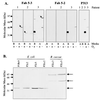Colonic bacteria express an ulcerative colitis pANCA-related protein epitope
- PMID: 10678972
- PMCID: PMC97313
- DOI: 10.1128/IAI.68.3.1542-1548.2000
Colonic bacteria express an ulcerative colitis pANCA-related protein epitope
Abstract
Bacteria are a suspected pathogenic factor in inflammatory bowel disease, but the identity of the relevant microbial species remains unresolved. The pANCA autoantibody is associated with most cases of ulcerative colitis (UC) and hence reflects an immune response associated with the disease process. This study addresses the hypothesis that pANCA identifies an antigen(s) expressed by bacteria resident in the human colonic mucosa. Libraries of colonic bacteria were generated using aerobic and anaerobic microbiologic culture conditions, and bacterial pools and clonal isolates were evaluated for cross-reactive antigens by immunoblot analysis using the pANCA monoclonal antibody Fab 5-3. Two major species of proteins immunoreactive to pANCA monoclonal antibodies were detected in bacteria from the anaerobic libraries. Colony isolates of the expressing bacteria were identified as Bacteroides caccae and Escherichia coli. Isolation and partial sequencing of the B. caccae antigen identified a 100-kDa protein without database homologous sequences. The E. coli protein was biochemically and genetically identified as the outer membrane porin OmpC. Enzyme-linked immunosorbent assay with human sera demonstrated elevated immunoglobulin G anti-OmpC in UC patients compared to healthy controls. These findings demonstrate that a pANCA monoclonal antibody detects a recurrent protein epitope expressed by colonic bacteria and implicates colonic bacterial proteins as a target of the disease-associated immune response.
Figures




References
-
- Altschul S F, Gish W, Miller W, Meyers E W, Lippman D J. Basic local alignment search tool. J Mol Biol. 1990;215:403–410. - PubMed
-
- Bouma G, Oudkerk P, Crusius J B, Schreuder G M, Hellemans H P, Meijer B U, Kostense P J, Giphart M J, Meuwissen S G, Pena A S. Evidence for genetic heterogeneity in inflammatory bowel disease (IBD); HLA genes in the predisposition to suffer from ulcerative colitis (UC) and Crohn's disease (CD) Clin Exp Immunol. 1997;109:175–179. - PMC - PubMed
Publication types
MeSH terms
Substances
Grants and funding
LinkOut - more resources
Full Text Sources
Other Literature Sources
Medical
Research Materials

